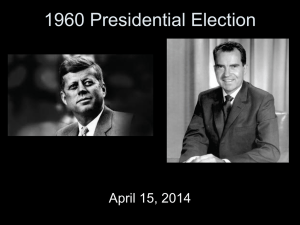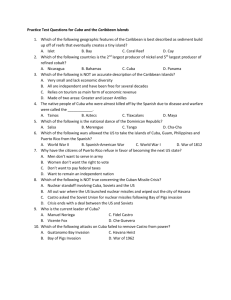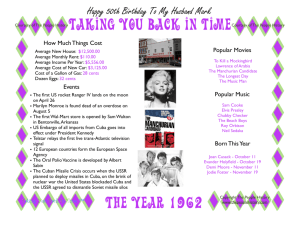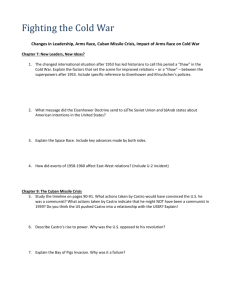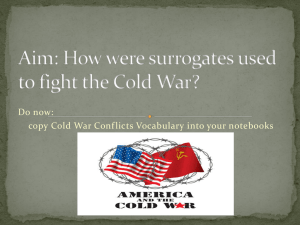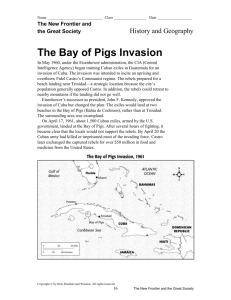The Cold War, 1961-68 - Libertyville High School
advertisement
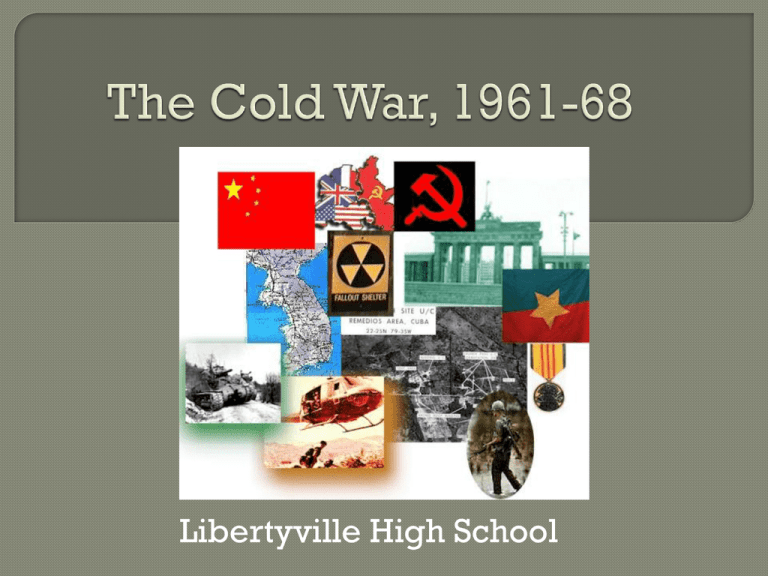
Libertyville High School Nov. 1958: Khrushchev demanded western powers leave West Berlin Khrushchev repeated same demand in June, 1961 • Kennedy increased size of military to 1.1 million • Authorized draft Thousands of East Berliners fled to West during crisis August 13, 1961: Border between E. Germany and W. Berlin closed On same day, border between E, W Berlin closed JFK ordered 150,000 troops to W. Berlin Standoff w/ East German troops continued through summer of 1962 Castro seized power in Cuba, 1959 Prior to invasion, US “owned” Cuba • Pro US government • US owned 4/5 of island utilities • ½ of sugar production • Nearly all mining • Mob dominated casinos Overthrowing Castro became focus for CIA March, 1960: Ike ordered invasion of Cuba • CIA would train Cuban immigrants / exiles • US would support invasion with bombers, supplies Cuba gov’t knew invasion was coming (loose lips, KGB info) Invasion itself a fiasco • 1300 ground troops supported by air sorties by WWII era airplanes • Three days of fighting left about 90 exiles dead; most surrendered, out of ammo • At UN, Cuban diplomats accused US of invasion • Adlai Stevenson: “under no circumstances” would US troops participate in combat in Cuba • About 100 Cuban exiles were executed; rest were exchanged in Dec. 1962 for $53 million in food, medicine ($ raised privately) Castro declared self a Marxist, accelerated nationalization of industries Castro driven firmly into arms of USSR (US saw as violation of what doctrine?) Soviets used invasion as pretext to send in military “advisors”, nuclear weapons Severe embarrassment for JFK Feb. 1962: JFK est. economic embargo of Cuba Castro was convinced of imminent US invasion Khrushchev decided to secretly place med. range nukes in Cuba Crisis at peak from October 8-28, 1962 • 10-14: U2 photos showed proof of buildup • JFK, 10-22-62: “It shall be the policy of this nation to regard any nuclear missile launched from Cuba against any nation in the Western Hemisphere as an attack on the United States, requiring a full retaliatory response upon the Soviet Union.” US est. strict quarantine on Cuba • Blockade of all supplies = declaration of war • Quarantine against weapons NOT a dec. of war Intense negotiations between JFK, Khrushchev • Khrushchev: US “pirate action” • Trade nukes in Turkey for nukes in Cuba? • US: no – just get’em out of Cuba Defcon 2, nukes loaded for attack against USSR Resolution • Khrushchev publicly agreed to remove missiles • JFK agreed to publicly state that US would never invade Cuba • Castro would publicly promise never to accept nukes in Cuba • JFK secretly removed nukes from Turkey To world, it looked like Khrushchev “blinked” Non-aligned nations Non-alignment policy of small countries • Policy: peaceful coexistence with the 1st, 2nd world nations was preferable & possible • Played US, USSR off against each other for cash, rewards Creation of Org. of African States (1963) • African states banded together vs. 1st World Invasion of Dominican Republic (1965) • 22,000 marines sent in • LBJ: Invasion to prevent OPEC Nations communist takeover • LBJ exaggerated threat, to press; start of “Credibility gap” Organization of Petroleum Exporting Countries (OPEC) formed 1960 • Resentment strong amongst oil producing 3rd World countries who were being exploited by West corps Khrushchev overthrown in 1964 • “Losing” Cuban missile crisis • Economic difficulties • Perceived loss of power within Politburo Replaced by Leonid Brezhnev • Conservative party leader • Chinese-Soviet relations deteriorate to warfare in 1969, over border De Gaulle protested strong US role in org. Developed French indep. army, from 1958 on • In event of war, intended to strike separate peace • 1959 – w/d Med fleet from NATO command • 1959 – banned stationing of nukes on French soil • 1966 – removed Fr. from NATO commands 1968: new Czech president, Dubcek, came to power • Loosened restrictions on media, speech, travel • Soviets objected August, 1968: Thousands of Soviet troops and tanks moved in Crackdown, occupation continued until 1990 “Triad” of strategy nuclear • Land based missiles Rockets for space program Large launch facility vulnerable to attack Missile silos first built in mid 1960s Multiple Independently Targetable Re-entry Vehicles (MIRV) were game changers • Bomber fleet B-52s continued to be updated • Submarine fleet Ballistic missile subs first deployed in 1959 Mutual Assured Destruction • First strike nation would still be wiped out by second strike capability of other country • Each nation a rational actor, intent on self preservation • Doctrine depends upon credibility of the threat of second strike = continual investment, updating nukes MAD Game Tree
